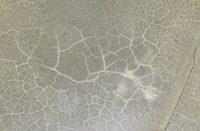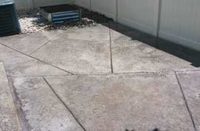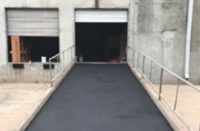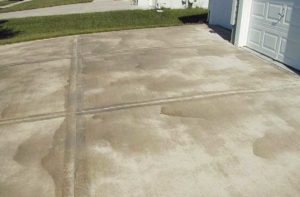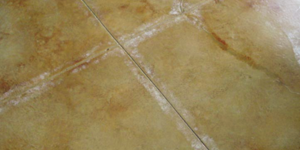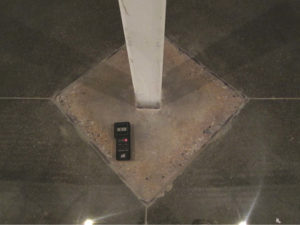
We’re in the middle of another winter season. While it’s not predicted to be as harsh as last year’s “polar vortex” winter, we still need to be thinking about all the possible causes and sources of winter damage and eliminate them.
A couple of recent articles in Concrete Decor have addressed this topic, but there’s still a lot more that can be said about how concrete holds up in winter. Freeze-thaw cycles, damage from salts and de-icers, and physical abrasion from plows, shovels and the like all take their toll. A report issued by the Minnesota Department of Transportation in August 2014 brings new fat to chew on: That report says colored concrete crosswalks, sidewalks and medians are deteriorating faster than plain gray concrete. That’s a blow to the heart of the decorative concrete industry, so we’ll look at what that actually means.
Before the pour
If you really want to control winter durability, you have to be aware of numerous factors:
- The concrete’s mix design,
- The slump of the placed concrete at the time of the pour,
- Properly preparing the subbase,
- How the concrete is worked in the finishing process, and
- How the concrete was cured in its first few days.
The weight of the concrete as it settles onto the subbase could result in cracking if the subbase is not properly prepped. Make sure the base is adequate for the job. When pouring in cold weather, do not expose the concrete until it develops at least 500 psi. It’s not easy to test for this, so use reasonable judgment to keep it covered and protected.
For concrete exposed to freezing and thawing temperatures in a harsh winter environment, and with possible exposure to de-icers (like from salts splashing up from slushy snow along roadways and driveways) the maximum water to concrete ratio by mass should be .40, with a minimum psi strength of 4,000.
The ‘slump’ of freshly mixed concrete is a measurement of consistency tallied in inches. Increasing the slump is typically done by increasing the water in the mix. Slumps greater than 4 inches will prolong the curing time, which you want to avoid in winter.
How the concrete is worked in the finishing process is important. Overworking the slab would cause the air entrainment at the surface to deplete, leading to possible surface issues. To avoid further problems, avoid premature troweling with a steel trowel. You do not want to trap moisture directly under the surface by steel troweling to avoid blistering.
Air-entraining creates tiny air bubbles in the mix that help reduce or absorb stresses from freeze-thaw cycles, so depleting this air entrainment would be a bad idea. Extended travel times of the fresh ready-mix concrete would deplete the air entrainment in the same manner. Damaging the air void system along the top surface also increases the risk of scaling.
Even if a contractor does all these things correctly, concrete can still be very easily damaged in the first year due to someone dumping de-icers onto its surface. After concrete has weathered a season or two and has gone through complete winter cycles for at least a year, it will naturally become more durable and resistant to de-icers.
No de-icer of any kind should be used on first-year concrete. Even if concrete was installed in April and sat all summer long, it will not gain the strength needed to resist the de-icers the first year. After year two, it will be more resistant.

Beware of freeze-thaw
Concrete seems like a dense material but in fact it is quite porous. As I said in my article from January, it’s helpful to think of concrete as a giant sponge, continually taking in and emitting moisture.
When concrete is saturated with water from rain or from snow piling up on it overnight and then melting during the day, ice crystals will form inside the concrete. When a small crack forms in concrete, water gets into it and it expands during freezing, making the crack just a little bigger so that more water can get into it next time.
Shoveling the snow off your driveway as soon as possible can help prevent this. Get that pile of wet, cold stuff off your concrete and let the sun dry it out and warm it up whenever it possibly can. Not to mention, this often makes your wife happier.
Use care with sealants
Sealants are designed to penetrate into the concrete to fill and seal the porous surface of the material. A good sealant job using silane or siloxane components will prevent water from reaching the inside of the concrete and will reduce much of the damage we just talked about.
However, that snow shovel or plow could abrade the surface, scraping off the sealant or exposing tiny cracks, so use care when using any hard, sharp tool on your concrete.
Climate change?
I know the debate is going on about whether climate change is real or not. I’m not a scientist but I do deal with a lot of science and chemistry in making sure my concrete is durable. An article published on Oct. 12, 2014, in The Boston Globe suggests climate change will mean that concrete has a shorter lifespan.
Northeastern University studied the issue and reported its findings in September in the journal Urban Climate. These researchers believe rising temperatures that are projected due to global warming will cause concrete to begin failing sooner than expected.
The building codes many of our modern city buildings were constructed under did not take this accelerated decay into account. So even high-quality buildings built to code will possibly be vulnerable sooner than expected.
These researchers calculated that structural trouble with concrete could start appearing as much as 25 years sooner than if global warming was not happening. The risks are greatest for buildings built in the 1950s and 1960s. Because they’re older and made from weaker concrete than we use today, they will be more vulnerable to freeze-thaw.
So what do we do? Researchers suggest increasing the thickness of concrete applied to buildings by 3 to 12 millimeters, which would be enough to offset enhanced decay rates. That would also increase building costs. The American Concrete Institute has not made a decision on this issue yet. Members and staff are currently reviewing guidelines, they say, to take these concerns into consideration.

Decaying decorative?
Now, about that Minnesota study. Full-depth colored concrete that’s part of street and roadway projects in Minnesota is deteriorating faster than expected, particularly near contract joints. The report says many projects exhibited panel cracking, either as a result of possible thermal expansion restraint or potentially some related expansive materials issues.
The researchers observed a significant number of projects with joint distress. Their investigation concluded “typical placement and finishing practices during construction were not a principal cause for the observed deterioration.” So what’s going on here? And is this an issue caused by the fact the concrete is decorative, or is something else causing the decorative concrete to become defective?
Strength testing of hardened colored concrete did not reveal significant differences from standard concrete. The team took core samples of the most distressed colored concrete and found a few key things. Air voids were adequate, however, a majority of the air voids near the joints were completely filled with mineral crystals, thus rendering the voids unable to provide freeze-thaw resistance. (Ettringite is a relatively new problem that affects portland cement. The mineral compound is formed in hydrated portland cement as a result of the reaction of calcium aluminate with calcium sulfate.) Also, the water-to-cementitious ratio was between 0.44 and 0.50, which exceeds the maximum of 0.45 for freeze-thaw resistance. A higher water-to-cement ratio correlates to higher porosity of the paste portion of the mix, which allows more moisture to penetrate the concrete.
Other projects showed joint distress that appeared to be associated with thermal expansion forces. Temperature measurements showed that darker colored concrete experienced up to 18 percent greater expansion than non-colored slabs. (That seems like a high percentage, but that’s what they measured.) They recommended designers place more emphasis on accounting for thermal expansion, particularly when two differently colored slabs are being laid out right next to each other.
Other recommendations included producing mixes with a lower water-to-cementitious ratio (≤ 0.43) and increasing consolidation of the mix during placement. Does that sound familiar? That’s what I recommended at the beginning of this article. Don’t think if you’re just “a little bit off” it won’t make a big difference. I always tell people that failing to prepare is the same as preparing to fail.
The researchers also recommend using a vibrating screed to level and consolidate the mix, but to be careful not to over-vibrate, as this may alter the entrained air system.
Take steps to keep colored concrete cool while it is curing, by providing shade or scheduling pours during times of minimal sun exposure. In winter, protect it from freezing and premature frost. Common curing materials for colored concrete include color waxes and clear compounds, both of which lack the heat-reducing reflectance provided by white pigmented curing compounds.
All in all, the report is an eye-opening look at how the elements we deal with on a daily basis, namely water—both in the mix and in the environment—and sunshine can have head-scratching effects on the material.
(Access the Minnesota report here: www.dot.state.mn.us/research/TS/2014/201426.pdf)
